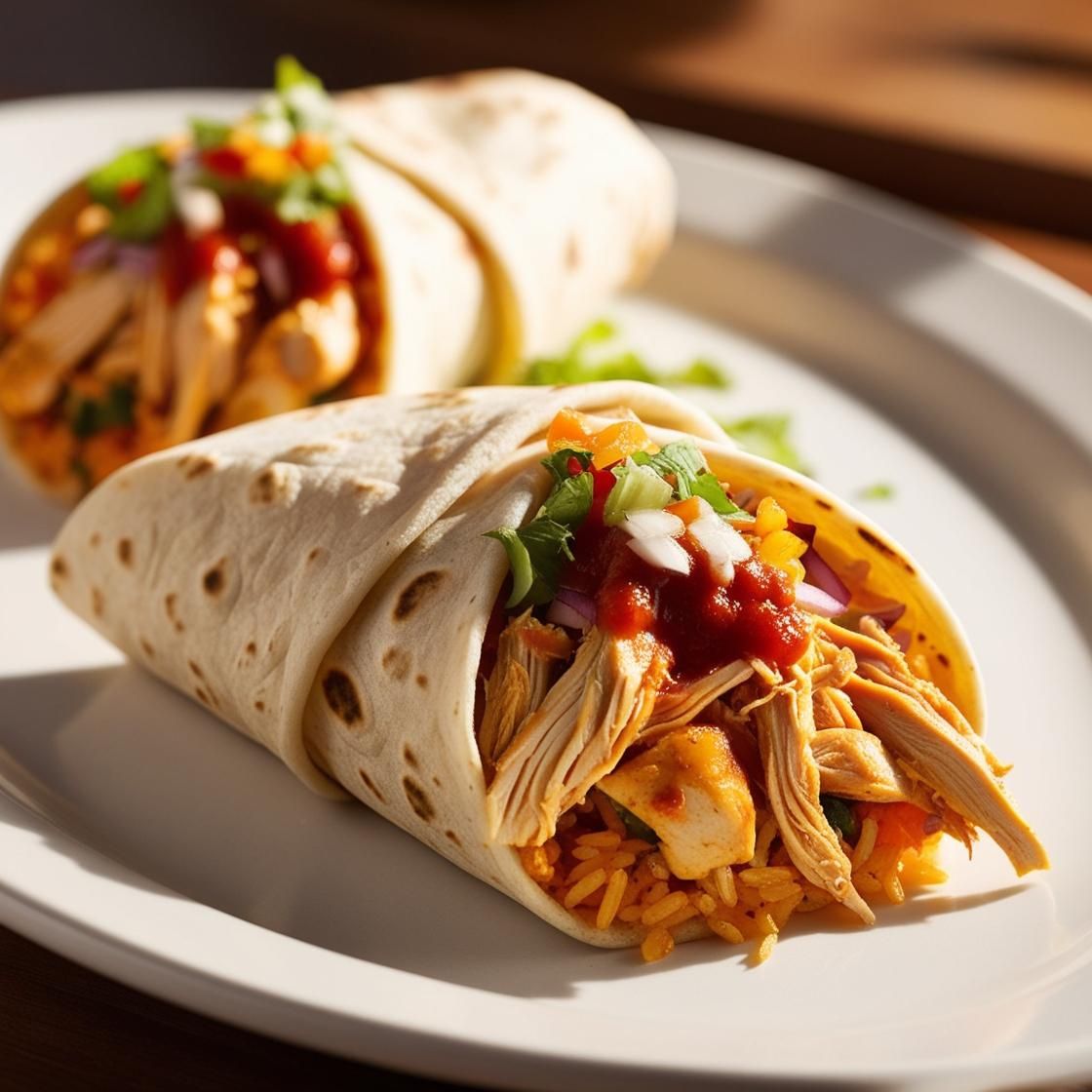Copycat Chipotle Burrito: Delicious Homemade Recipe to Satisfy Your Cravings

If you're a fan of the bold flavors and customizable options at Chipotle, you're not alone. Many of us crave that satisfying experience at home without the ever-increasing price tag. The good news is, with this restaurant recipe, we can create our very own Chipotle burrito, or copycat chipotle chicken burrito bowl, with just a few simple ingredients and steps.
In this blog post, we will share the key components needed to replicate that beloved burrito. From choosing the right rice to layering on the perfect amount of toppings, we’ll guide you through each step to ensure our homemade version captures the essence of the original.
Get ready to impress your friends and family with our take on this iconic meal. It's a straightforward recipe that brings the taste of Chipotle right to our kitchen table.
History of the Burrito
The burrito has a rich history rooted in Mexican culture and has significantly evolved in the United States. We explore its origins and the adaptations that have made it a popular dish.
Origins in Mexican Cuisine
The burrito's history traces back to the Mexican state of Chihuahua, where we find its initial forms in the late 19th century. The term "burrito," meaning "little donkey" in Spanish, likely refers to the way these rolled tortillas carry their fillings.
Traditional burritos consisted of flour tortillas filled with various ingredients such as beans, meat, and cheese. These simple, hearty meals were practical for workers and travelers, offering nourishment and convenience. As we delve into Mexican culinary traditions, we see that these early burritos were often enjoyed alongside local sauces, highlighting the vibrant flavors of the region.
Adaptation and Evolution in the United States
When burritos crossed the border into the United States, particularly in the 20th century, they began to evolve. We started to see regional variations, particularly in California and Texas. The introduction of larger, more elaborate burritos reflected local tastes and preferences.
In the U.S., ingredients expanded to include rice, guacamole, and a wide variety of salsas. New concepts like the "California burrito," filled with carne asada and French fries, emerged. Fast-casual dining chains further popularized this dish, leading to the creation of numerous variations that cater to diverse palates. The burrito became a cultural phenomenon, blending Mexican heritage with American innovation.
Breaking Down the Copycat Chipotle Burrito
Creating a copycat Chipotle burrito requires a focus on quality ingredients and a balance of signature flavors. We will explore the essential components and cooking techniques that help achieve an authentic taste.
Ingredients and Quality
To craft the perfect copycat burrito, we emphasize using fresh ingredients. Quality plays a crucial role in replicating the flavors we love.
Key Ingredients Include:
- Rice: Cilantro-lime rice is ideal. Adding fresh lime juice and chopped cilantro elevates the flavor.
- Protein: Options like grilled chicken, steak, or sofritas provide variety. Seasoned correctly, they mimic the original’s taste.
- Beans: Both black and pinto beans can be used. They should be seasoned to enhance their earthiness.
- Toppings: Fresh pico de gallo, cheese, sour cream, and guacamole are essential. Using ripe avocados ensures a rich, creamy texture.
We find that sourcing local produce can improve freshness and taste significantly.
Signature Flavors and Techniques
Achieving the distinctive Chipotle taste involves specific techniques and flavor pairings. Mastery of these elements is vital.
Flavor Combinations:
- Marinades: Utilizing marinades for proteins, such as adobo or chipotle seasoning, adds depth.
- Sautéing: Quick sautéing enhances flavors, especially for vegetables in the burrito.
- Layering: Proper layering of ingredients enhances texture and taste. We recommend starting with rice and adding proteins and toppings gradually.
Incorporating lime juice and fresh herbs throughout our preparation helps construct a bright, well-rounded flavor profile. This attention to detail is what brings our burrito close to the original.
Making Your Own Burrito
Creating a homemade burrito gives us the freedom to select our own ingredients and flavors. We can tailor every aspect to our taste, from the base to the toppings.
Step-by-Step Copycat Chipotle Burrito Recipe
Ingredients
Chipotle Marinated Chicken:
- 2 dried guajillo chilies
- 2 dried ancho chilies
- 4 dried mushrooms
- 1.5 cups boiling water
- 2 tsp (4g) coriander seeds, toasted
- 2 tsp (4g) cumin seeds, toasted
- 7oz (200g) can chipotle peppers in adobo
- 4 cloves garlic
- 1 tsp (3g) ground cinnamon
- 2 tsp (12g) kosher salt
- Juice of 1 lime
- 4 Tbsp chili oil or neutral oil
- 1.5 lbs boneless skinless chicken thighs
Homemade Flour Tortillas:
- 2 cups (300g) all-purpose flour
- 1 tsp (4g) kosher salt
- 1/2 tsp (2g) baking powder
- 1/4 cup vegetable oil
- 3/4 cup warm water
Beans:
- 4–5 slices bacon
- 1 yellow onion, thinly sliced
- 4 cloves garlic, minced
- 1 large jalapeño, thinly sliced
- 1 can black beans, drained
- 1/2 cup (120ml) chicken stock
- 2 Tbsp (24g) unsalted butter
- Salt and pepper to taste
Cilantro Lime Rice:
- 4 cups cooked rice
- Zest and juice of 1 lime
- Zest of 1 lemon
- Juice of 2 limes
- 1/4–1/2 cup fresh chopped cilantro
- 2 Tbsp unsalted butter
- Salt to taste
Instructions
Chipotle Marinated Chicken:
- Remove stems and seeds from dried chilies. Place chilies and mushrooms in a bowl, cover with boiling water, and cover with plastic wrap. Let steep.
- Toast coriander and cumin seeds in a dry pan over medium heat until fragrant, about 1–2 minutes.
- Grind toasted seeds in a blender until powdered. Add rehydrated chilies and mushrooms, 2–3 Tbsp of soaking liquid, chipotle peppers, garlic, cinnamon, kosher salt, and lime juice. Blend until smooth.
- While blending, slowly stream in chili oil until emulsified.
- Pour marinade over chicken in a bowl, toss to coat, and marinate in the fridge for at least 1 hour or overnight.
- Cook chicken in a hot pan with oil until browned and cooked through, flipping occasionally. Optionally, finish in a 400°F oven until internal temp reaches 165°F.
Tortillas:
- In a bowl, mix flour, kosher salt, and baking powder. Stream in hot water, then oil, while mixing. Knead into smooth dough.
- Cover and rest 1–2 hours. Divide into 6 balls, roll out to 12" diameter on floured surface.
- Cook each tortilla in a hot dry cast iron pan for 15–30 seconds per side. Keep warm under a towel.
Beans:
- Cut bacon into 1/2" pieces and cook in a skillet until crispy. Remove bacon and reserve.
- In bacon fat, cook onions with salt until soft. Add garlic and sauté until fragrant.
- Add jalapeños and cook briefly. Stir in black beans and chicken stock. Simmer until reduced.
- Stir in butter off heat. Reserve until ready to serve.
Cilantro Lime Rice:
- Cook rice and place in a bowl. Add lime zest and juice, lemon zest, cilantro, butter, and salt. Stir to combine.
Assembly:
- Slice cooked chicken into bite-sized pieces.
- Lay a tortilla flat. Add rice, beans, chicken, optional toppings like diced tomato, avocado, cheese, and cotija.
- Fold sides in and roll tightly from the bottom up.
Customization and Variations
Customization is key to our burrito-making experience. We can switch up the protein based on preference, from shredded pork to tofu for a vegetarian option.
For the rice, we can opt for brown rice, cauliflower rice, or skip it entirely for a low-carb version. Adding beans is also a great protein option.
Toppings can vary widely; think about pico de gallo, sour cream, or jalapeños. We might include unique flavors like mango salsa or chipotle sauce for an extra kick.
Finally, consider different sauces or marinades for our protein, such as teriyaki or barbecue, creating a fusion burrito that reflects our culinary tastes.
